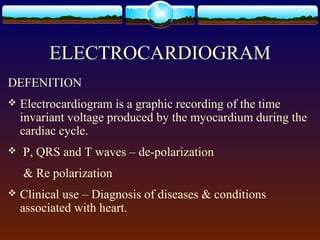
Electrocardiogram
- 1. ELECTROCARDIOGRAM DEFENITION Electrocardiogram is a graphic recording of the time invariant voltage produced by the myocardium during the cardiac cycle. P, QRS and T waves – de-polarization & Re polarization Clinical use – Diagnosis of diseases & conditions associated with heart.
- 2. ECG 3. Ventricular repolarization 1. Atrial depolarization
- 3. Electrocardiography (ECG) 2. Ventricular 3. Ventricular repolarization depolarization 1. Atrial depolarization
- 4. Sum of all cardiac action potentials Amplitude: 1-5 mV Bandwidth: 0.05-100 Hz
- 5. Cardiologists looks critically At various time intervals Polarities and amplitudes
- 6. Normal values of ECG parameters Amplitude P 0.25 mv R 1.6 mv Q 25 % of R wave T 0.1 to 0.5 mv
- 7. Duration P-R interval 0.12 to 0.20 sec Q- T interval 0.35 to 0.44 sec SW- T segment 0.05 to 0.15 sec P wave interval 0.11 sec QRS interval 0.09 sec
- 8. Diagnosis of cardiac diseases First the the heart rate – 60- 100 beats/ min ( Normal value) Slower than this ( bradycardia) Higher than this ( Tachycardia ) Check whether the cycle is evenly spaced – If not Arrhythmia
- 9. If PR interval > 0.2 sec ---BLOCKAGE OF AV node If one or more of the basic features of ECG are missing -----indicate HEART BLOCK
- 10. Device – Electrocardiograph Advantage Can provide several diagnostic information Disadvantage Can not provide information about the disorders involving heart valves. Angiography and Echocardiography
- 11. Electrodes and leads Lead --- The particular electrodes selected and the way in which they are connected to the amplifier are called lead For the individual lead wire, as well as the physical connection to the body of the patient, the term electrode will be used.
- 12. 3- Bipolar Limb lead --- Einthoven
- 13. Einthoven Postulated 1. At any instant of the cardiac cycle, the frontal plane representation of the electrical axis of the heart is a two dimensional vector. 2.Einthoven also made the assumption that the heart is near the centre of an equilateral triangle, the apexes of which are the right and left shoulders and the crotch.
- 14. 3. By assuming that the ECG potentials at the at the shoulders are same as the wrists and the potential at the crotch differ little from those at either ankle, he let the points of this triangle represents the electrode positions for the 3- limb leads. THIS TRIANGLE IS KNOWN AS EINTHOVEN TRIANGLE
- 16. The sides of the triangle represents the lines along which the three projections of the ECG vector are measured. Based on this Einthoven showed that , the instantaneous voltage measured from any one of the three limb lead positions is approximately equal to the algebraic sum of the other two. THE VECTOR SUM OF THE PROJECTIONS ON ALL THREE LINES IS EQUAL TO ZERO.
- 17. 12-Lead ECG Measurement Most widely used ECG measurement setup in clinical environment Signal is measured non-invasively with 9 electrodes Lots of measurement data and international reference databases Well-known measurement and diagnosis practices This particular method was adopted due to
- 18. 12 Lead ECG Measurement Einthoven leads: I, II & IIIGoldberger augmented leads: Precordial leads: V1-V6 V R, V L & V F
- 19. Voltage generated by the pumping action of the heart Is a vector – Magnitude as well as spatial orientation changes with time. ECG signal is measured from electrodes applied to the surface of the body. Waveform of ECG signal is depended on the placement of electrode.
- 20. ELECTRODES Einthoven – Record ECG from electrodes placed vertically as well as horizontally to the body. Experiments with immersion electrodes--- Placed electrodes not only on the arm but also on one leg.– Left Leg. Electronic amplifiers ----Ground reference. ( RL )
- 21. ECG Recording set up
- 22. SPECIFICATIONS OF ECG Frequency response – Upper 100Hz, Lower 50 Hz Sensitivity – 20 mm/mV Input impedance 5 Mega ohms Output impedance Less than 100 ohms Standardization signal 1 mv CMRR 10,000: 1 Recording – heated stylus and heat sensitive paper
- 23. Paperspeed 25 mm/sec or 50 mm/sec Frequency response 0.1 to 60 Hz.
